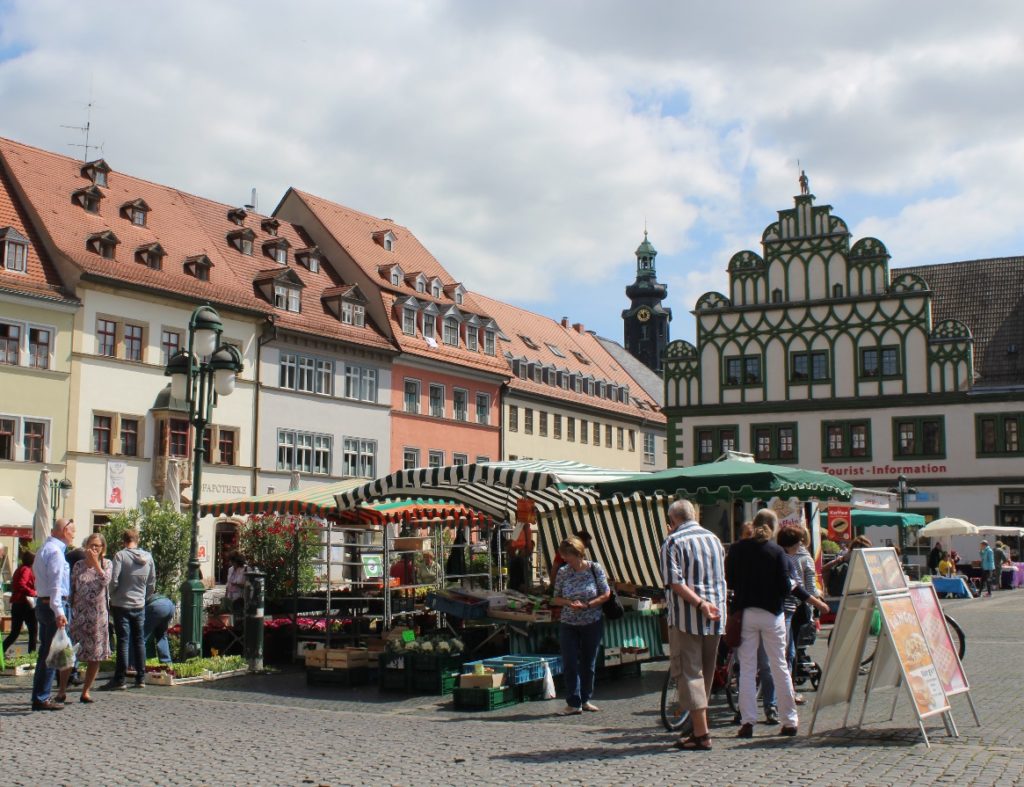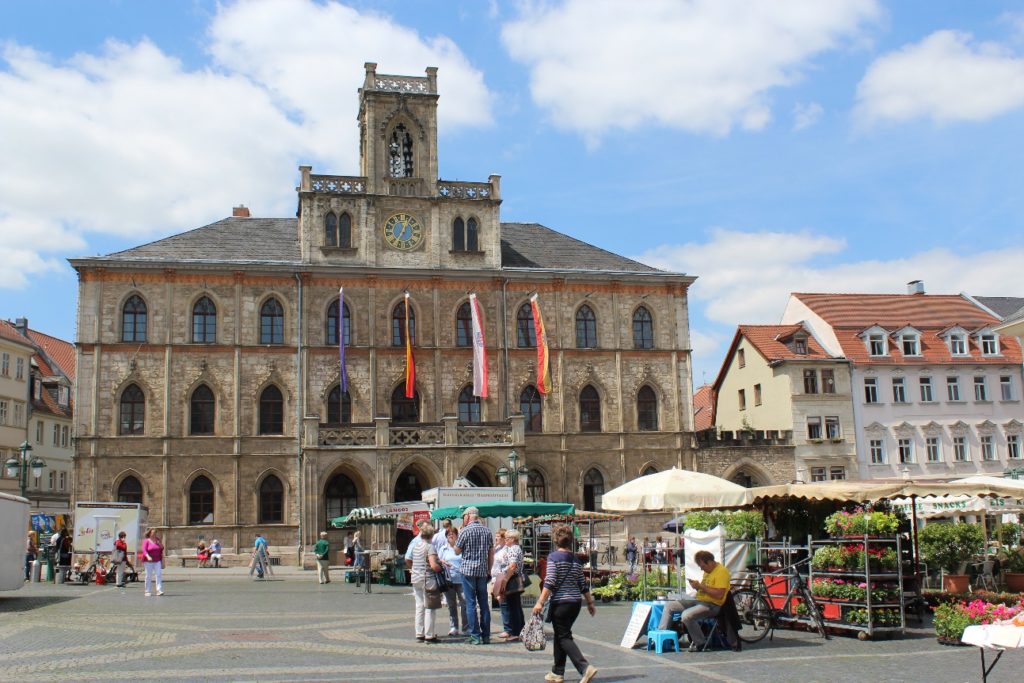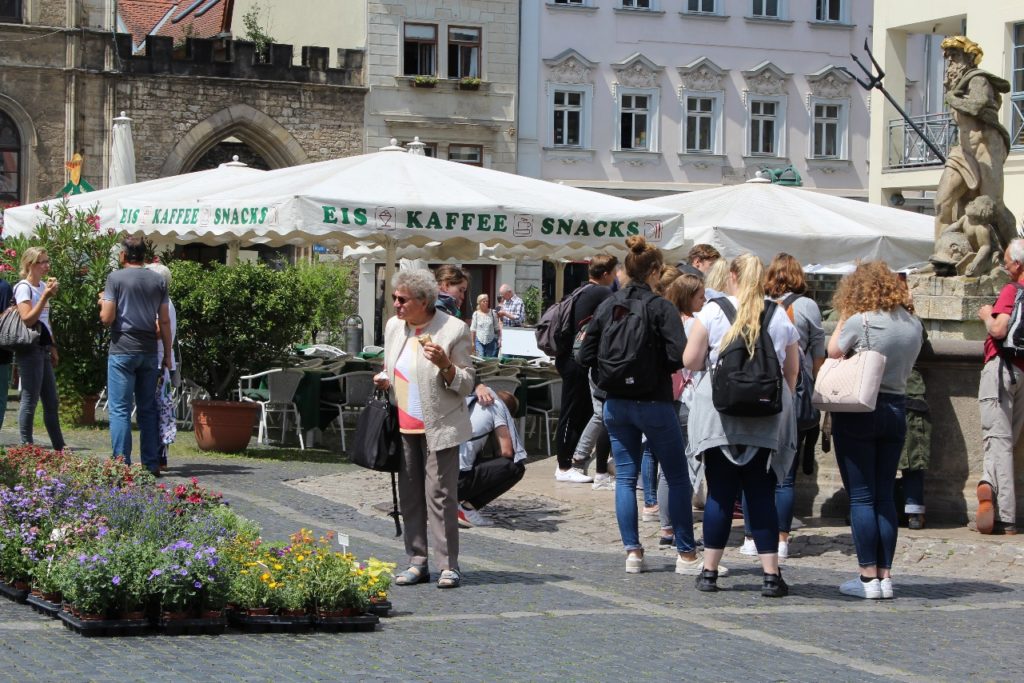It’s past 10 in the morning in the market place of Naumburg. A few pigeons, a group of German tourists and a handful of local passers-by dot the expanse of the square where in medieval times scores of merchants would have set up their stalls, where their voices would have met the requests of scores of clients, and where social interaction and gossiping would have been the other trades of the place. It’s past 10 in the morning and the town hall towers over the market place. The nearby Stadtmuseum houses old measures and weights, what allowed the local authorities to regulate commerce in the market place of Naumburg in the Middle Ages.

It’s past 10 in the morning, and more than the town hall, it is the community church of St Wenzel that casts its shadow over the market place. Its imposing clock tower marks the hours. It also marks the years and the centuries since Naumburg was created, much benefitting from the right to have a regular market. A symbol of peace and stability, of the expanse of the cash-based economy and improved economic performance, as well as of a less agrarian and more urban social structure, the market town is one of the most important achievements of medieval times. Its allure has lasted to our times. It’s past 10 in the morning, surrounded by cafeterias, an optics, a jewelry and a shoe shop, a tavern or two and an old hotel, the market place of Naumburg has left behind the sonorous maze of the Middle Ages and stands quiet awaiting an audience almost invariably German-speaking.

In the nearby town of Weimar, the market place speaks German too. But it also speaks foreign languages. Foreigners cut through it in their visit of the birthplace of Bauhaus, the town that linked its name to that of Goethe and Schiller, and the Republic of Weimar. The souvenir shops around it attest to the influx of tourists. “And when Weimar was the Capital of Culture this square was overcrowded!” exclaims a man with a stall who sells matrioshka dolls. They first came to town in the time of the German Democratic Republic and stayed through the new economic order always in company of each other, the wooden dolls and the seller, two symbols of Russia in the market place of a town that stands symbol of Germany. “In GDR times, the market place was more lively”, he argues, and adds: “Yes, locals come here, but it’s mostly elderly people. They buy vegetables. It’s a habit. They used to do it in their childhood and afterwards. Now, for example, an old lady can still come here at 9 am and by 10 am go home with everything she needs. And locals think that vegetables here are fresh and grown by their sellers. I don’t think so”, he maintains. A woman who sells hot-dogs and other meat products, is frying some meat. “I have had my stall here for nearly 20 years now. Previously there were many butchers. Now there are only three of us. Yes, I can say that the market is now smaller. Maybe because old sellers are dying, and no one takes their place.” The matrioshka dolls seller agrees. “Some sellers died” he says and adds emphatically, “And young people prefer supermarkets.” So, why does he insist in selling traditional Russian dolls in the market place of Weimar? “Hah, he exclaims, in Moscow you can buy Chinese underpants, what’s the problem with selling matrioshkas here?” Is this the answer for the survival of the medieval market place in Europe?

- Changing Times, Changing Habits
One of the purposes of the current article is to look at cultural heritage from a different angle. Shall we consider the way public spaces are used by the community as part of a town’s heritage? When we talk about heritage, why not think about some habits of our daily life that we observe in our towns and cities? Are these cultural habits affected by social and economic changes? Squares, in this sense, have always had an important role. As mentioned, in medieval times, they were places of trade and exchanges, the centre around which many European cities were formed. No wonder that the most important buildings are often surrounding such spaces. Today, squares are markets, meeting points where you can relax and socialise, and perfect locations for public events.

Indeed, squares are dynamic places that change constantly. In the past centuries, the houses overlooking the Marktplatz in Weimar were occupied by prominent people, like the Cranachhaus built in 1549 by Nikolaus Gromann. It belonged to a Chancellor named Christian Brück, son-in-law of the famous painter LucasCranach the Elder. The house got its current name from its most famous residents, the painters Lucas Cranach the Elder himself and his son Lucas Cranach the Younger, who both lived there during the 16th century. However, times change and now in the building right next to this Renaissance house you will find the tourist information office. On the opposite side, there is Weimar’s Rathaus – closed to the public at the time of our visit. All around, some cafés and restaurants, souvenir shops, plus the historic Hotel Elephant.

Now, take a few minutes to sit on a bench and look around. What kind of people do you see? What are they doing? Visitors waiting outside the tourism office – meaning Weimar is nowadays a stop on the tourist trails; elderly locals shopping from the market stalls – like the Russian seller said; young students on a break who seem very keen on looking at their phones. People from different generations, with different backgrounds and habits. All of them spending time in the square, giving this space a meaning and a purpose.

